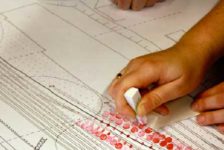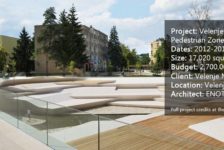Drawing is a great tool for recording and analyzing spaces. Sometimes such a drawing also needs to capture the depth of space. I’m going to show you some tricks that will help you achieve this in a drawing.
As usual, I begin the drawing with an outline of all the elements in the image. In a many layered drawing like this, it is important to distinguish between front and back layers for the sake of understanding the image. By graphically differentiating the layers we create the illusion of depth.
One way of achieving this is to add more textures and detail up front and reduce them in more distant layers. I draw roof tiles on the front buildings, windows, tree branches and other detail such as texture of the raised within the gardens. In the back layers, I use less and less detail, and only leave the outlines of the further most layers. However, I do add detail to the church, as it is a landmark in this landscape and thus important.
The illusion of depth can be achieved also by adding color. We can do this by painting the front layers with intensive colors and the back layers with mild colors. I leave the most distant layers blank. When drawing fast with watercolors you should also remember that accuracy isn’t important, but rather the overall feeling of depth the color provides.
(Related Article: Hand Drawing Tutorial: How to Choose Your Pen and Sketchbook)
Linescapes is a project focused on exploring drawing techniques for recording and analyzing landscapes. It also tries to promote hand-drawing in landscape architecture.
You can also follow Linescapes on Youtube, Twitter, and Facebook!
Published in Blog









